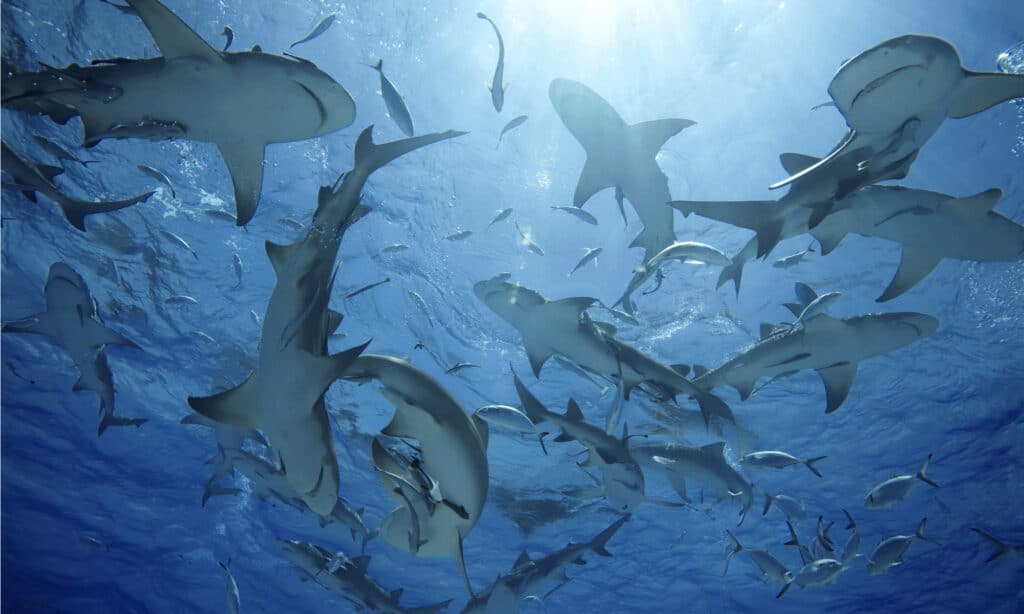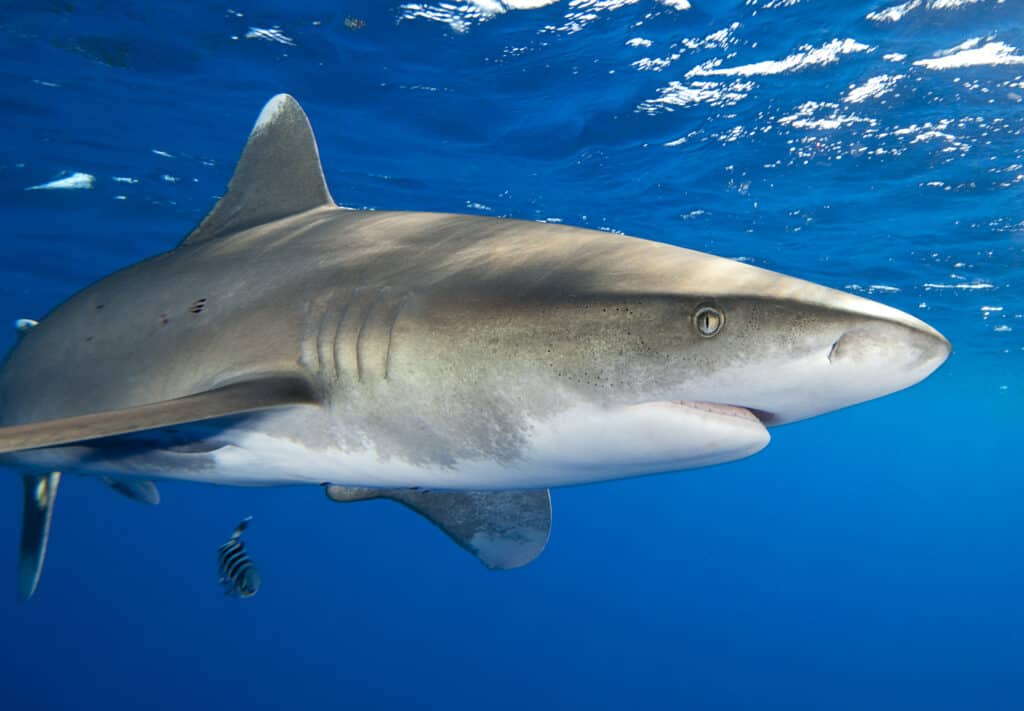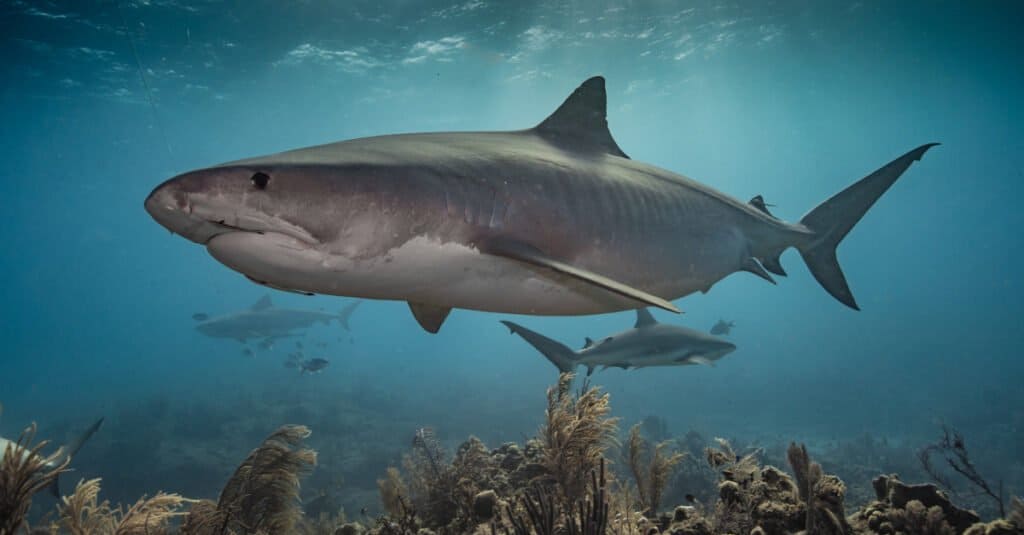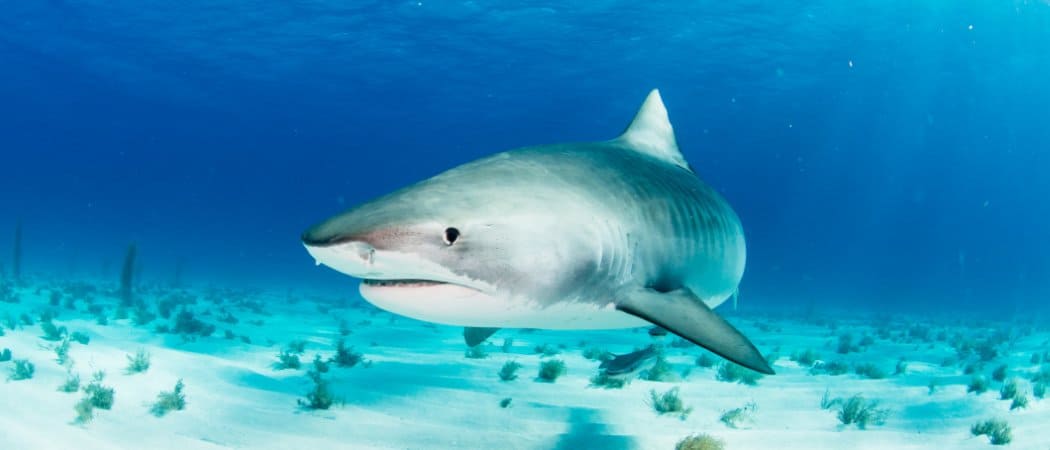Sharks are incredible, deadly predators. They can detect chemicals from hundreds of meters away in small quantities, sense the electrical discharge from living beings, and have insanely powerful bites. Fortunately, shark attacks are very uncommon. Somewhere between 50 and 100 shark attacks occur every year, and only 10 or so are fatal. Yet, one attack that took place in July 1945 saw up to 150 people or more killed by sharks in the space of about five days. Let’s take a closer look at the grim history of the deadliest shark attack in human history.
We’ll show you the events leading up to the attack, what types of sharks were responsible for the frenzy, and the myths surrounding the attack.
The USS Indianapolis Sinks in Shark-Infested Waters

Sharks are curious creatures that can sense prey from far off.
©Yann hubert/Shutterstock.com
In the waning days of World War II, the USS Indianapolis was tasked with a top-secret mission. This mission was to deliver parts of the “Little Boy” nuclear bomb. This weapon would eventually be dropped on Hiroshima, helping to end the final phase of the war.
On July 26, the ship completed its mission and sailed to Guam to take on other sailors and continue to Leyte. On July 30, 1945, the USS Indianapolis was attacked by a Japanese submarine. Torpedoes ripped into the ship. Roughly 300 of the 1,195-man crew went down with the ship, and the rest were left in the open waters. Most went into the water without food, drinkable water, or life jackets.

A memorial dedicated to the sinking of the USS Indianapolis.
A series of communication failures took place in the following days. The US Navy didn’t recognize that they were missing a ship, and it wasn’t until a plane on patrol spotted the survivors over 3 days later that rescue operations began. In the meantime, the explosions and the human activity in the water drew hundreds of sharks to the area.
It is believed that 890 people went into the water that day but only 316 living people were eventually rescued.
The Deadliest Shark Attack in Human History Commences

The oceanic whitetip shark is appropriately named due to the white tip on its fin.
©A Cotton Photo/Shutterstock.com
The survivors in the water faced horrible conditions. The impacts of dehydration, saltwater poisoning, drowning, and other maladies killed the vast majority of the people in the water.
During the first afternoon in the water, groups of sharks approached the floating mass of survivors in the open ocean. By nightfall, they were picking off those that had already died as a result of injuries sustained during the torpedo assault. The sharks would continue to show a preference for dead sailors, scavenging them as easy prey.
The sailors soon figured out the horrible truth that injured sailors were the next targets for sharks. The smell of their blood in the water was drawing more sharks. The sailors packed as many injured people as possible onto their meager rafts. The severely injured and dead were also separated from healthy sailors to stem the attacks.

Survivors of the harrowing sinking of the USS Indianapolis.
©Sailor or employee of the U.S. Navy / Public Domain – Original / License
The shark attacks continued in the following days. One sailor believes the attacks were the worst on the third day as shark attacks continued amongst the survivors. Meanwhile, exhaustion and delirium brought on by heat and ingesting saltwater continued to lead to more deaths.
Some sailors tried to eat their rations. Yet, they soon discovered eating would draw sharks to them, so they got rid of the food.
The sharks attacked the sailors up until the day that a passing patrol flight accidentally discovered the men floating in the ocean. Commander Robert Marks and his crew on a seaplane were the first to arrive at the scene on August 2, 1945. The crew defied orders, landed in the ocean, and brought men on board while acting as a buoy for other sailors. By nightfall, ships arrived to rescue the remaining crew, and the sailors were finally safe from the sharks.
What Kinds of Sharks Attacked the USS Indianapolis Crew?

The
tiger
shark is one of the deadliest sharks in the world and was probably at the USS Indianapolis.
©iStock.com/Howard Chen
Ocean whitetip sharks and tiger sharks attacked the USS Indianapolis crew members. At least, they’re the most likely culprits. Determining which sharks attacked the USS Indianapolis crew is difficult. Many of the attacks happened in the late afternoon and night.
The oceanic whitetip sharks are known to be highly aggressive and very opportunistic with their prey. Ocean whitetop sharks are found in pelagic areas like the one where the USS Indianapolis sank. These sharks are not as massive as a great white, but they are more than powerful enough to kill humans.
These sharks are known by some as the deadliest sharks to humans for their habit of swarming downed planes and sinking ships. In fact, the RMS Nova Scotia was also torpedoed during World War II, losing 858 of the 1052 people on board. Many of their deaths were attributed to whitetip sharks.
Tiger sharks are also powerful creatures that have some camouflage making it hard to spot them from above. These sharks could have also participated in the attack on the USS Indianapolis crew.
How Many People Died in the Deadliest Shark Attack in Human History?

Some sharks are more aggressive than others.
©Gino Santa Maria/Shutterstock.com
Determining how many people died as a direct result of shark attacks after the ship sank is difficult. Estimates claim that somewhere between a few dozen people and over 150 people died during the shark attacks.
On the low end, it’s believed that a few dozen sailors perished from the ocean white-tip sharks and tiger sharks. If that were true, this event would still be the deadliest shark attack in history. If sharks killed 150 people during that attack, it would equal about 15 years’ worth of fatal shark attacks in the present.
No matter how you view it, this was the worst shark attack ever recorded. Scientists have dispelled the myth that several hundred people died from sharks during the USS Indianapolis sinking. However, a significant amount of people did die from shark attacks, and it’d be wrong to dismiss the claims of those who were in the water at the time as false.

A ceremonial burial-at-sea firing of 3 volleys for World War II Mate 2nd Class Eugene Stanley Morgan, one of the 316 survivors of the sinking of the World War II cruiser USS Indianapolis.
©U.S. Navy photo by Lt. Gabriel Hernandez / Public Domain – Original / License
Not only did the sinking of the USS Indianapolis lead to the deadliest shark attack in history, but it was also the greatest single loss of life at sea in the entire U.S. Navy’s history. Sadly, only two survivors of the USS Indianapolis remain as of the time this article was published.
According to the USS Indianapolis website, they are Harold John Bray, JR, Seaman 2C, and Cleatus Archie Lebow, Fire Controlman Operator 3C.
Thank you for reading! Have some feedback for us? Contact the AZ Animals editorial team.








